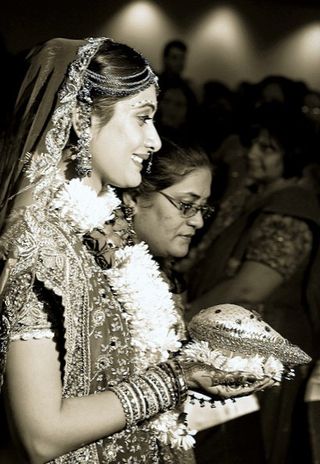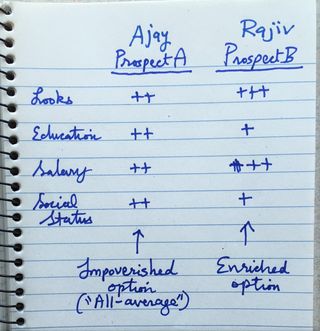Marriage
2 Ways to Prescreen Candidates for Indian Arranged Marriage
Decision making research explains how inclusion and exclusion methods differ.
Posted June 7, 2016
As I have written before, I am utterly fascinated by the nearly universal practice of arranged marriage in India. Even as other things westernize rapidly, the institution of arranged marriage continues to thrive there. Even most upper middle-class, highly educated Indian men and women find their spouses through arrangement rather than a love match. And a majority of them go on to have long-lived and happy marriages. (Dating apps like Tinder are still a fringe service in India, and I will write more about this in a future blog post).
So what is a traditional Indian arranged marriage?
In a love marriage, the person meets a prospective partner, dates, and often lives with them before proposing marriage. In contrast, when most Indians are ready to marry, parents or relatives act as intermediaries. They solicit marriage proposals through the family’s network, and ads in newspapers and matrimonial websites. Much like a job application, prospective matches reply to these ads sending their “biodata”. Then parents screen the applications and make a shortlist for the individual to consider further.

During this process, there isn’t any dating involved in the Western sense of the concept. But the individuals – men and women usually have veto power. After a few chaperoned meetings, each of them can reject the match or agree to it. If the match is rejected, they move on to the next candidate on their shortlist. This process continues until a match is approved by both parties. Then the marriage is planned and occurs in due course.
I want to explore the question of how someone interested in an arranged marriage should go about choosing their marriage partner to maximize chances of a successful outcome. In this blog post, I will focus on the first step in this process. Specifically, how should parents and intermediaries prescreen prospects? Behavioral decision theory research provides some interesting insights.
(But one important caveat first: this post is not to be construed as advice in making arranged marriage decisions. Everything is discussed here in very general terms. Where marriage decisions are concerned, every situation is unique, and the devil’s in the details.)
Prescreening arranged marriage prospects using inclusion and exclusion methods
Let’s say Arup and Savitri are Indian parents who want to marry off their daughter Priya. They place ads on appropriate matrimonial sites and end up with exactly one hundred potential suitors for Priya. How should they prescreen and generate a shortlist for Priya to consider further?
Decision making research has looked at how people prescreen options in numerous contexts from hiring decisions in a company to the number of toppings on a pizza. In each case, the decision maker faces the same problem: there are far too many options to consider in-depth so the list has to be pared down to a manageable few for further serious consideration.
This research suggests Arup and Savitri can use one of two prescreening methods. An “inclusion” method is more positive and geared towards keeping candidates for further in-depth consideration by Priya. In a typical psychology study, the instruction for inclusion would read like this: “After examining each of the 100 candidates who have applied for Priya’s hand, choose those you would like Priya to seriously consider for marriage.”
Or they can use the “exclusion” approach where the focus is on rejecting candidates if they do not satisfy a criterion. For exclusion, the instruction would be: “After examining …, reject the ones that you would not like Priya to seriously consider for marriage.
How does prescreening using inclusion versus exclusion differ?
The bottom line is that the final shortlist of candidates for Priya will be different based on which prescreening method Arup and Savitri use. How? In two ways, in the number of shortlisted options, and in the options included in the shortlist.
#1. Number of shortlisted options
Counterintuitively, when people use the exclusion method to prescreen, they keep more candidates on the list than when they use the inclusion method. Why does this happen? Psychologists have discovered two reasons. First, decision makers tend to favor the status quo. As psychologists Ilan Yaniv and Yaacov Schul observe:
“The inclusion procedure might suggest to the judge that admitting an alternative into the final set requires a good reason or an explanation, whereas letting an alternative remain outside the final set is the default or `status quo' and requires no special explanation. Thus, with the inclusion procedure the judge is primarily accountable for admitting an alternative into the set. The elimination procedure might create the opposite perception. Here the default is to let an option remain inside the choice set, whereas eliminating an alternative from the set requires an explanation.”
And second, because people tend to have a “positivity bias” when judging others, they screen out fewer candidates when asked to judge their negative characteristics and to reject them.
From this research, the message to Arup and Savitri is clear. The prescreening method you use will dictate how long your shortlist is. Use the inclusion method if you want a short shortlist. And pick the exclusion method if you want Priya to have a longer shortlist (and potentially more flexibility) in choosing her husband.
#2. Which options are included in the shortlist

Consider two of the prospects who want to marry Priya. Ajay is average in pretty much every criterion (looks, salary, education, and social status), while Rajiv is stellar on some criteria (he is a handsome dude who earns a lot of money), but below par in other things (he’s a high school dropout with dismal social status). Who should Arup & Savitri shortlist for Priya?
In an influential paper in the early 1990s, psychologist Eldar Shafir showed that when decision makers use exclusion, they tend to favor all-average or so-called “impoverished” options like Ajay. But when using an inclusion approach, they tend to like “enriched” options like Rajiv, who is really strong on some dimensions but weak in others. Why?
Shafir explains the reason as follows:
“…the positive and negative dimensions of options (their pros and cons) are expected to loom larger when one is choosing and when one is rejecting, respectively….Because positive dimensions are weighted more heavily in choosing than in rejecting, and negative dimensions are weighted more heavily in rejecting than in choosing, the enriched option tends to be chosen and rejected relatively more often than the impoverished option.”
So which strategy is better in prescreening prospective grooms for Priya? There isn’t one right answer. As the research shows, it depends on whether Arup and Savitri want to provide Priya with a list of mediocre plodders or dodgy upstarts to choose from.
And of course, the next question is: Now that Priya has her shortlist of candidates vetted by mum and dad, how many of these men should Priya meet and interview in-depth before selecting her life-long groom? I will consider this question in a future blog post.
If you are interested in reading more about arranged marriages, you may enjoy my other posts on this topic:
- Why Are So Many Indian Arranged Marriages Successful?
- How Do Indian Women Fare In An Arranged Marriage?
About Me
I teach marketing and pricing to MBA students at Rice University. You can find more information about me on my website or follow me on LinkedIn, Facebook, or Twitter @ud.




